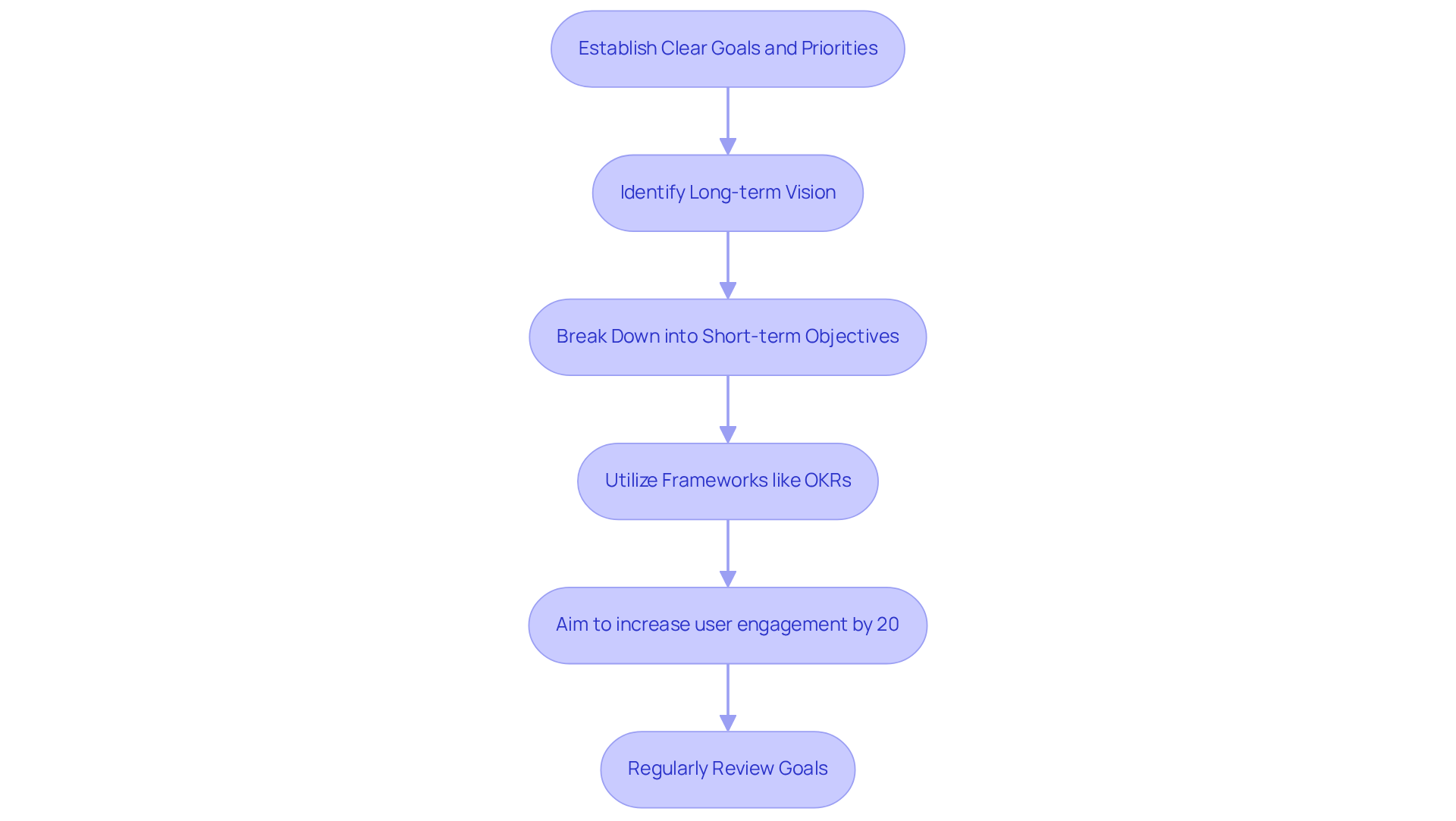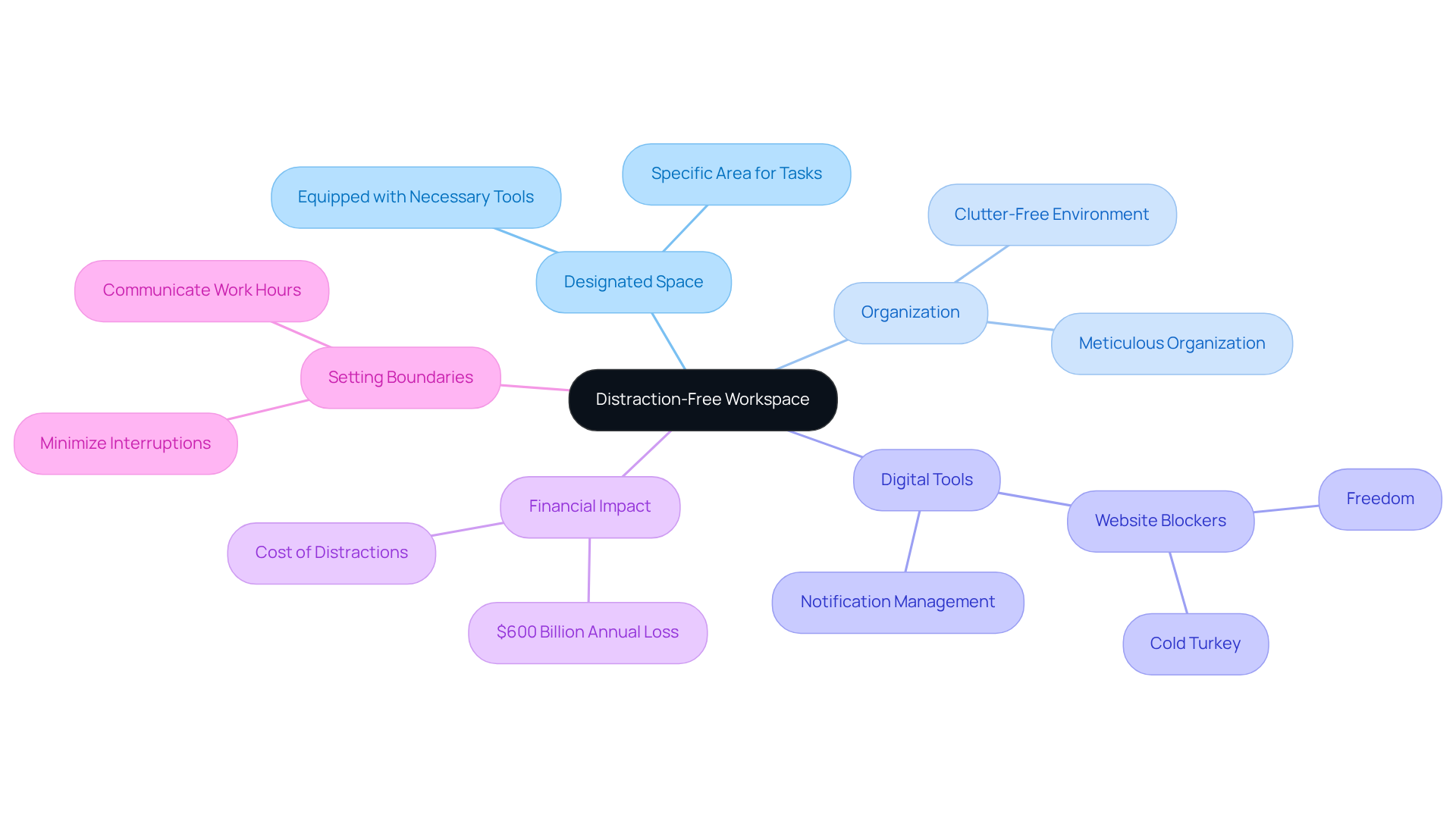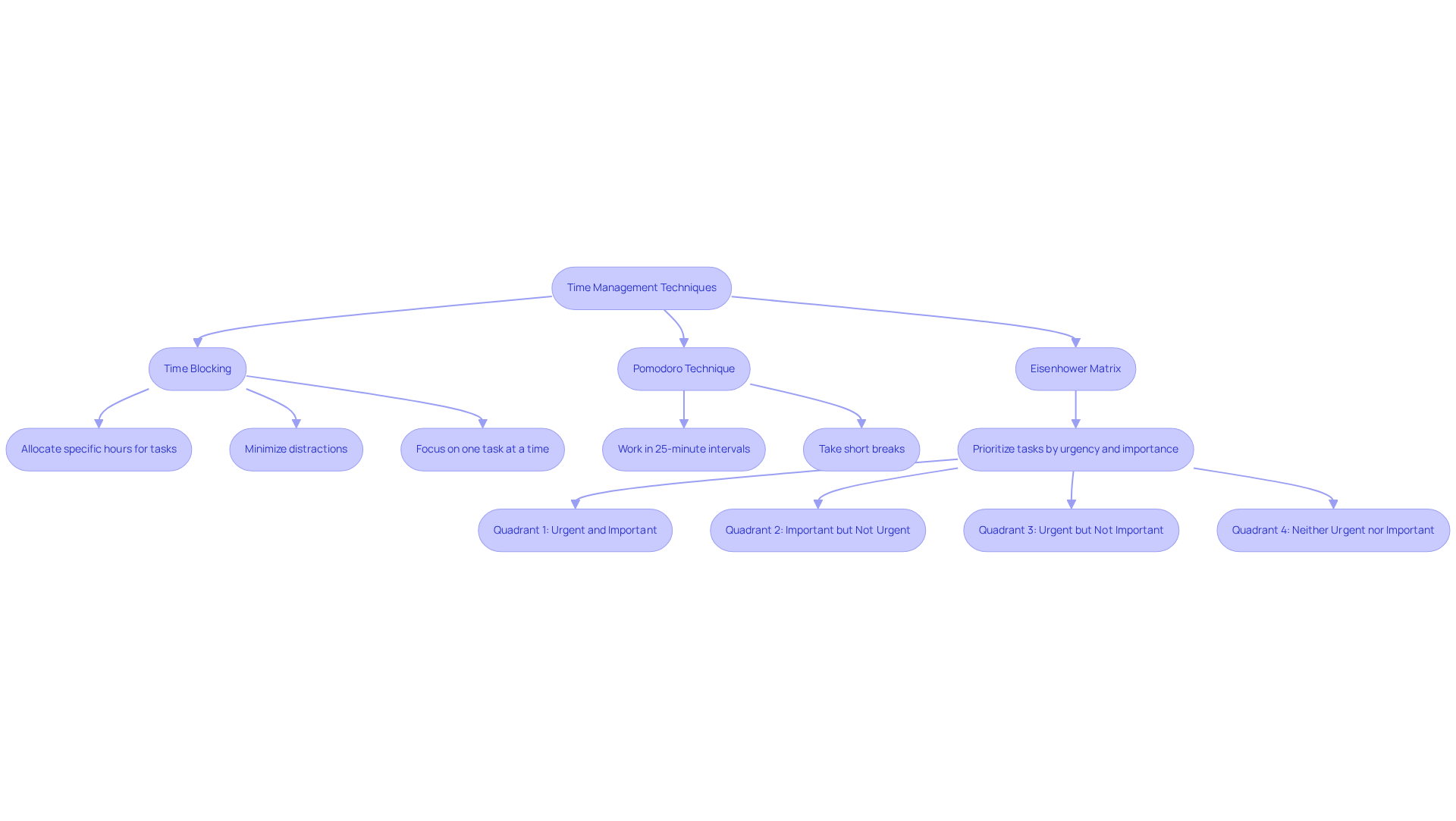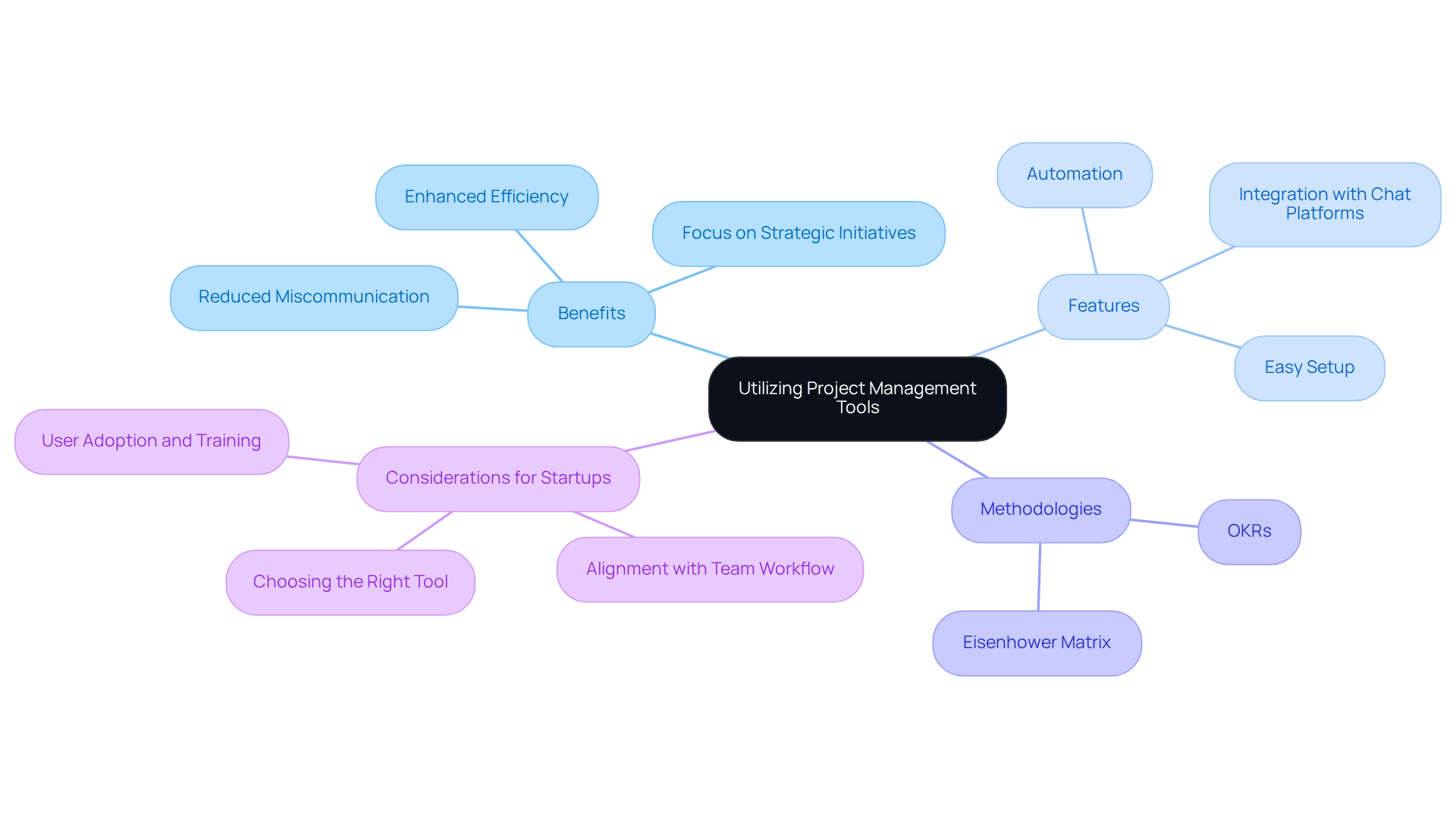Overview
The article presents four essential strategies for startup founders aiming to maintain focus:
- Establishing clear goals and priorities
- Creating a distraction-free workspace
- Implementing effective time management techniques
- Utilizing project management tools for efficiency
Each strategy is backed by research and practical examples that illustrate how structured goal-setting, an organized environment, disciplined time allocation, and the strategic use of technology can significantly enhance productivity. These elements collectively ensure that founders remain aligned with their business objectives.
Have you considered how these strategies could transform your approach? By integrating a clear set of goals, you not only define your path but also create a framework that minimizes distractions. An organized workspace fosters creativity and clarity, while disciplined time management techniques allow for optimal allocation of resources. Moreover, leveraging project management tools can streamline processes and enhance efficiency.
In conclusion, adopting these strategies not only boosts productivity but also empowers founders to navigate the challenges of startup life with confidence and purpose.
Introduction
In the tumultuous journey of launching a startup, maintaining focus often seems like an elusive goal. Founders face a barrage of distractions and competing priorities, making it crucial to implement strategies that promote clarity and productivity. This article explores four essential approaches that not only enable startup leaders to maintain their focus but also propel their ventures toward success. How can founders effectively navigate this chaos and ensure their vision remains central to their daily operations?
Establish Clear Goals and Priorities
To effectively establish clear goals and priorities, founders must first identify their long-term vision and then break it down into actionable short-term objectives. Utilizing frameworks like OKRs (Objectives and Key Results) is essential for setting measurable targets. For example, a startup might aim to increase user engagement by 20% over the next quarter, with key results that include:
- Launching a new feature
- Conducting user feedback sessions
Research shows that:
- 83% of companies utilizing OKRs report positive impacts on their organization
- 90% report enhanced communication and strategy implementation
Regularly reviewing these goals—at least quarterly—ensures that the team remains aligned and can pivot as necessary based on market feedback or internal performance metrics. Notably, companies that review goals quarterly are 31% more likely to achieve them than those that do not. This dynamic approach not only enhances clarity but also fosters innovation and commitment among team members, as those involved in the goal-setting process are significantly more likely to be staying focused on the organization's objectives.
Furthermore, it is crucial to avoid common pitfalls in goal setting, such as overloading oneself with too many goals, which can negatively impact staying focused and effectiveness. Are you ready to refine your approach to goal setting?

Create a Distraction-Free Workspace
To establish a distraction-free environment, founders must designate a specific space solely for their tasks, equipped with all necessary tools and resources. This space should be meticulously organized and free from clutter; disorganization can significantly hinder productivity. In fact, studies show that over 50% of our waking time is spent thinking about something other than the task at hand.
Furthermore, leveraging digital tools that block distracting websites and notifications is crucial. Applications like Freedom or Cold Turkey can effectively help maintain focus during critical tasks. Notably, U.S. businesses lose a staggering $600 billion annually due to workplace distractions, underscoring the financial ramifications of neglecting this issue.
Additionally, entrepreneurs should establish clear boundaries with family or housemates to minimize interruptions during work hours. By creating an environment for staying focused, entrepreneurs can dramatically enhance their productivity and effectively pursue their business objectives.

Implement Time Management Techniques
Startup creators can significantly enhance their productivity by implementing effective time management techniques such as time blocking. This method involves allocating specific hours for different tasks, ensuring that critical activities benefit from staying focused attention. For instance, an entrepreneur might dedicate mornings to strategic planning and afternoons to team meetings, optimizing their workflow throughout the day. Research indicates that only 18% of the population possesses a well-structured and functional time management system, highlighting the importance of adopting effective strategies.
The Pomodoro technique further enhances this method by promoting tasks in concentrated intervals of 25 minutes, followed by brief breaks. This structured approach not only aids in staying focused but also prevents burnout, allowing founders to sustain their energy over longer periods. Studies show that individuals who are staying focused in their work patterns can achieve greater efficiency and quality in their outputs. However, it's essential to be mindful of potential pitfalls, such as the risk of procrastination if breaks are not managed effectively.
Additionally, utilizing the Eisenhower Matrix to prioritize activities can further enhance productivity. By organizing duties into urgent and important quadrants, founders can ensure that staying focused on what truly matters maximizes their limited time. For instance, activities that fall into Quadrant 1—urgent and important—should be addressed promptly, while Quadrant 2 activities—important but not urgent—can be planned for later, allowing for strategic progress without the pressure of immediate deadlines. Casy's methodologies, including the Eisenhower Matrix, can help groups prioritize their work effectively.
Incorporating these techniques not only streamlines daily operations but also fosters a culture of accountability and focus within the startup, ultimately driving success.

Utilize Project Management Tools for Efficiency
Leveraging project management tools like Casy can dramatically enhance a startup's operational efficiency. By automating project creation, monitoring progress, and improving group communication, these tools empower founders to concentrate on strategic initiatives, staying focused instead of becoming bogged down by administrative tasks. Casy, for instance, integrates seamlessly with chat platforms, automatically capturing essential information from discussions and converting it into actionable tasks—no manual input required. This unique capability to function without extensive setup is especially advantageous for rapidly advancing teams.
Additionally, Casy employs built-in methodologies such as OKRs and the Eisenhower Matrix, which assist teams in prioritizing their work effectively. This automation not only saves valuable time but also helps in staying focused, significantly reducing the likelihood of miscommunication among team members. As the trend of adopting project management solutions continues to rise among startup founders, it becomes increasingly important to explore various options. Identifying the tool that best aligns with your team's workflow and objectives ensures alignment and accountability across the board.
Are you ready to elevate your startup's efficiency?

Conclusion
Establishing focus as a startup founder is crucial for navigating the challenges of entrepreneurship. By implementing clear goals and priorities, creating a distraction-free workspace, mastering time management techniques, and utilizing project management tools, founders can significantly enhance their productivity and drive their ventures toward success.
This article outlines four essential strategies:
- Setting measurable objectives using frameworks like OKRs to maintain alignment and foster innovation.
- Designing an organized workspace to minimize distractions.
- Employing effective time management techniques such as time blocking and the Pomodoro technique.
- Leveraging project management tools to streamline operations and improve team communication.
Each of these strategies plays a vital role in helping founders maintain focus and achieve their long-term vision.
Ultimately, the ability to stay focused transcends personal discipline; it’s about creating an environment and adopting practices that foster productivity and clarity. By embracing these strategies, startup founders can better navigate their entrepreneurial journeys, ensuring that they remain aligned with their goals and responsive to their teams and market demands. Taking actionable steps today can lead to significant advancements in both personal effectiveness and overall business success.
Frequently Asked Questions
How can founders establish clear goals and priorities?
Founders can establish clear goals and priorities by identifying their long-term vision and breaking it down into actionable short-term objectives. Utilizing frameworks like OKRs (Objectives and Key Results) is essential for setting measurable targets.
What is an example of a measurable target using OKRs?
An example of a measurable target using OKRs could be a startup aiming to increase user engagement by 20% over the next quarter, with key results that might include launching a new feature and conducting user feedback sessions.
What impact do companies report when utilizing OKRs?
Research shows that 83% of companies utilizing OKRs report positive impacts on their organization, and 90% report enhanced communication and strategy implementation.
How often should companies review their goals?
Companies should regularly review their goals at least quarterly to ensure that the team remains aligned and can pivot based on market feedback or internal performance metrics.
What is the likelihood of achieving goals for companies that review them quarterly?
Companies that review their goals quarterly are 31% more likely to achieve them compared to those that do not.
What benefits does a dynamic approach to goal setting provide?
A dynamic approach to goal setting enhances clarity and fosters innovation and commitment among team members, as those involved in the goal-setting process are more likely to stay focused on the organization's objectives.
What common pitfalls should be avoided in goal setting?
Common pitfalls to avoid in goal setting include overloading oneself with too many goals, which can negatively impact focus and effectiveness.




